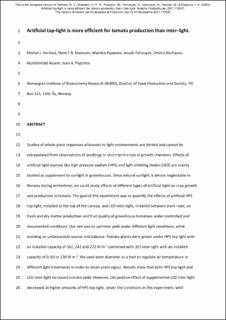| dc.contributor.author | Verheul, Michel | |
| dc.contributor.author | Maessen, Hendricus | |
| dc.contributor.author | Paponov, Martina | |
| dc.contributor.author | Panosyan, Anush | |
| dc.contributor.author | Kechasov, Dmitry | |
| dc.contributor.author | Naseer, Muhammad | |
| dc.contributor.author | Paponov, Ivan | |
| dc.date.accessioned | 2022-01-26T09:56:00Z | |
| dc.date.available | 2022-01-26T09:56:00Z | |
| dc.date.created | 2022-01-20T15:35:27Z | |
| dc.date.issued | 2022-09-17 | |
| dc.identifier.citation | Scientia Horticulturae. 2021, 291 . | en_US |
| dc.identifier.issn | 0304-4238 | |
| dc.identifier.uri | https://hdl.handle.net/11250/2839393 | |
| dc.description.abstract | Studies of whole-plant responses of tomato to light environments are limited and cannot be extrapolated from observations of seedlings or short-term crops in growth chambers. Effects of artificial light sources like high pressure sodium (HPS) and light emitting diodes (LED) are mainly studied as supplement to sunlight in greenhouses. Since natural sunlight is almost neglectable in Norway during wintertime, we could study effects of different types of artificial light on crop growth and production in tomato. The goal of this experiment was to quantify the effects of artificial HPS top-light, installed at the top of the canopy, and LED inter-light, installed between plant rows, on fresh and dry matter production and fruit quality of greenhouse tomatoes under controlled and documented conditions. Our aim was to optimize yield under different light conditions, while avoiding an unfavourable source-sink balance. Tomato plants were grown under HPS top light with an installed capacity of 161, 242 and 272 W m−2 combined with LED inter-light with an installed capacity of 0, 60 or 120 W m−2. We used stem diameter as a trait to regulate air temperature in different light treatments in order to retain plant vigour. Results show that both HPS top light and LED inter-light increased tomato yield. However, the positive effect of supplemental LED inter-light decreased at higher amounts of HPS top light. Under the conditions in this experiment, with neglectable incoming solar radiation, an installed amount of 242 Watt m-2 HPS top light and a daily light integral (DLI) of 30 mol m-2 day-1 resulted in best light use efficiency (in gram fresh tomato per mol). Addition of LED inter-light to HPS top light reduced light use efficiency. Results show that winter production using artificial light in Norway is more energy efficient compared to production under sunlight in southern countries. Results can be used for modelling purposes. | en_US |
| dc.language.iso | eng | en_US |
| dc.publisher | Elsevier B.V. | en_US |
| dc.rights | Attribution-NonCommercial-NoDerivatives 4.0 Internasjonal | * |
| dc.rights.uri | http://creativecommons.org/licenses/by-nc-nd/4.0/deed.no | * |
| dc.title | Artificial top-light is more efficient for tomato production than inter-light | en_US |
| dc.type | Peer reviewed | en_US |
| dc.type | Journal article | en_US |
| dc.description.version | acceptedVersion | en_US |
| dc.rights.holder | © 2021 Published by Elsevier B.V. | en_US |
| dc.source.pagenumber | 11 | en_US |
| dc.source.volume | 291 | en_US |
| dc.source.journal | Scientia Horticulturae | en_US |
| dc.identifier.doi | 10.1016/j.scienta.2021.110537 | |
| dc.identifier.cristin | 1986506 | |
| dc.relation.project | Norges forskningsråd: 255613 | en_US |
| dc.source.articlenumber | 110537 | en_US |
| cristin.ispublished | true | |
| cristin.fulltext | postprint | |
| cristin.qualitycode | 1 | |

